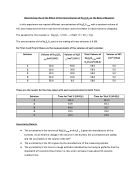Determining the of the Effect of the Concentration of Na2S2O3 on the Rate of Reaction
Determining the of the Effect of the Concentration of Na2S2O3 on the Rate of Reaction
In this experiment we reacted different concentrations of Na2S2O3 (aq) with a constant volume of HCl, and measured the time it took for the X drawn under the beaker in black marker to disappear.
The equation for this reaction is: Na2S2O3 + 2 HCl → 2 NaCl + S + SO2 + H2O
The concentration of the Na2S2O3 used in the making of these solutions is 0.2M.
For Trial 1 and Trial 2 these are the measurements of the volumes of each solution:
These are the results for the time taken with each concentration for both Trials:
Uncertainty Details:
- The uncertainty in the volume of Na2S2O3 (aq) and H2O (l) is given by manufacturer of the burettes. As we find the change in the volume in the burette, the uncertainties are added, and the uncertainty in the volume is ±0.1cm³
- The uncertainty in the HCl is given by the manufacturer of the measuring cylinder.
- The uncertainty in the time is a rough estimate calculated by me trying to perfectly stop the stopwatch at 5 seconds three times in a row, and in all cases it was about 0.4 seconds reaction time.
- The uncertainty in Total Volume of Na2S2O3 (aq) and H2O is found by adding the uncertainty in the volume of H2O and the uncertainty in the volume of Na2S2O3.
Observations:
- We stirred all solutions.
- There is a small delay between when we started the stop watch and poured the HCl, as it is impossible to perfectly coordinate this.
- Bad smell released.
- The stirring speed was not the same for each reaction, though it was attempted to be replicated equally for each reaction.
- The uncertainty given by the last figure on the stop watch was very inaccurate to use, therefore we calculated the reaction time instead to give a more true uncertainty. However this value has a range, so it is not necessarily accurate.








